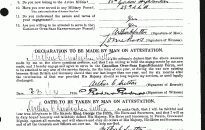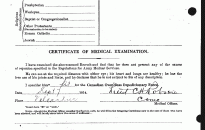Overview

Arthur Christopher Sutton was born on 17 January 1887 in Brighton, Sussex Bay, England.[1] He would eventually settle in Victoria, British Columbia where he would serve with the
Victoria Police Department. The English immigrant joined the 50th (Gordon Highlanders) Regiment, raised in Victoria, in 1913 as Private Arthur Christopher Sutton, 28581. When war broke out in 1914, he was among the first to volunteer. When he arrived in Valcartier, Quebec, Sutton was 6 ft and 2 ½ inches tall with a scar and a “fleshy mole” ½ inches to the right of his spine.
Sutton proved to be an outstanding soldier and a source of pride for the city of Victoria. During the Great War, Arthur Christopher Sutton would serve in the 16th, 67th Pioneer, and 11th Battalions. He would receive the Distinguished Service Order and was Mentioned in Despatches, both honours for soldiers in the British Empire at the time, and would rise through the ranks from private to major of the 16th C.E.F. Battalion and lieutenant-colonel of the 67th Canadian Pioneer Battalion. By the end of the war he reverted to the rank of major. He continued his service in Siberia from 1918-9 where he would finally be “struck-off-strength” on 28 June 1919. He returned to Victoria after his military service.
Before Deployment Overseas
Born in England, Sutton would move to Victoria, British Columbia. In Victoria he served in the Victoria Police Department and later in the 50th (Gordon Highlanders) Regiment when it was formed in 1913.[2] When Britain joined the Great War in August 1914, Sutton was among the first volunteers to leave Victoria for service overseas in the Canadian Expeditionary Forces. In September 1914 in Valcartier, Quebec, Sutton was assigned to “A” Company, 16th C.E.F. Battalion as a lance corporal.[3]
With the 16th C.E.F. Battalion
LCpl. Sutton arrived in France on 9 February 1915 and would be deployed to the Ypres Salient that same month.
When the Germans attacked, Sutton was at St Julien where the Canadians famously made a stand against the German artillery barrages combining chlorine gas and shrapnel shells.[4] On 24 April Sutton was wounded-in-action three times [5] and post-battle would be sent to England for recuperation.[6] He would recover and later receive a promotion to sergeant and become an instructor in England.[7] However he returned to Canada afterwards.
With The 67th Canadian Pioneer Battalion
Upon arrival in Canada, Lieutenant-Colonel Lorne Ross organized the 67th Battalion with Sutton accepting a commission as a lieutenant.[8] The 67th later headed for England and it was there that Lieutenant Sutton commanded No. 3 Company as a major in the battalion.[9] Major Sutton served with his unit on the front from 13 August 1916 to 24 June 1917.[10] It is likely Sutton was attached to the men of
No. 3 Company, 67th Canadian Pioneer Battalion as he refused a promotion to lieutenant-colonel twice before he accepted it[11] as well as continuing the serve with his unit despite being injured on 13 February 1917.[12]
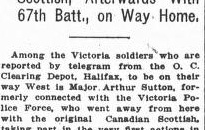
He likely fought in the battles of Ancre Heights (October to November 1916 as part of the Battle of the Somme) and Vimy Ridge (April 1917 as part of the broader Battle of Arras) given the time frame spent with his battalion. During this period he received the Distinguished Service Order (D.S.O.) and was Mentioned in Despatches.[13] An article by The Daily Colonist noted he proved “his fitness for his post and the duties which it [his post] imposed he discharged [carried out] with conspicuous ability.”[14]
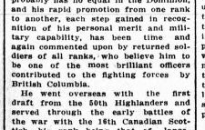
He was later sent back to Canada along with some survivors of the First Contingent in April 1918 per the recent regulations in effect.[15]
Last Years of Military Service
Lieutenant-Colonel Sutton was later sent on a British military mission to the United States from 24 April to 17 September 1918. He was assigned to the training depot in Quantico, Virginia, United States where he, “in no small way,” trained American soldiers. [16] Shortly after, he served in the 11th Battalion stationed in Canada from 18 September to 14 November 1918. His services and skill were required one last time during the Siberian Expedition. He served in the Russian hinterland from 26 December 1918 to 19 May 1919. At some point during the expedition, Sutton was reverted back to the rank of “major.” After five years of extraordinary military service, Sutton was “struck-off-strength” on 28 June 1919.[17] He would return to Victoria, B.C. post-war and was present during the unveiling of the memorial tablet in 1919.
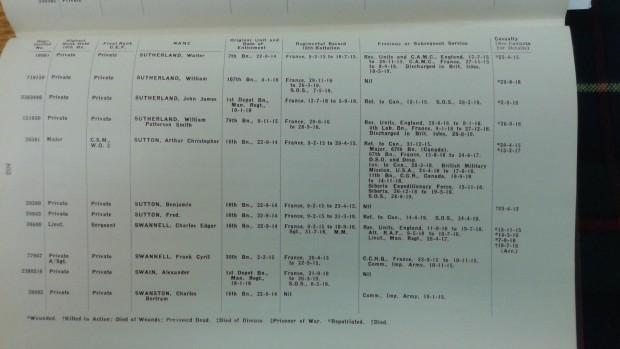
Written by Joseph Yuson.
References
[1] Sutton, Arthur Christopher. Service no. 28581. Attestation Paper, 1. Library and Archives Canada. RG 150, Accession 1992-93/166, Box 9442-11.
[2] “History of The Canadian Scottish Regiment (Princess Mary’s),” in The Canadian Scottish Regiment. http://www.canadianscottishregiment.ca/index.php?page_id=1024.
[3] Lieutenant-Colonel H. M. Urquhart. The History of the 16th Battalion (The Canadian Scottish) Canadian Expeditionary Force In the Great War, 1914-1919. Toronto: The MacMillan Company of Canada, Limited, 1932: 803.
[4] “St. Julien Memorial,” on Veteran Affairs Canada. http://www.veterans.gc.ca/eng/remembrance/memorials/overseas/first-world-war/belgium/stjulien.
[5] History of the 16th Battalion, 803.
[6] “Victorian Gains Rapid Promotion: From Private at Outbreak of War to Lieutenant-Colonel Is Record for Former City Policeman.” The Daily Colonist, 31 May, 1917: 5. http://archive.org/stream/dailycolonist59y148uvic#page/n3/mode/1up.
[7] Ibid.
[8] Ibid.
[9] Ibid.
[10] History of the 16th Battalion, 803.
[11] The Daily Colonist, 31 May, 1917: 5.
[12] History of the 16th Battalion, 803.
[13] Ibid.
[14] The Daily Colonist, 31 May, 1917: 5.
[15] The regulations allowed the First Contingent men to have three months’ leave. “One of ‘Originals’ With Men Westbound. Major Arthur Sutton, Who Left in 1914 with Canadian Scottish, Afterwards with 67th Batt., on Way Home.” The Daily Colonist, 10 April 1918: 5. http://archive.org/stream/dailycolonist60y106uvic#page/n3/mode/1up.
[16] “Approve Appointment of Major A. Sutton, Experience in Training Camps of Three Different Countries Qualifies Officer for Post at C.E.F. (Siberia) Base, Vladivostok.” The Daily Colonist, 19 November 1918: 10. http://archive.org/stream/dailycolonist60y300uvic#page/n8/mode/1up/search/sutton+tablets.
[17] History of the 16th Battalion, 803.
